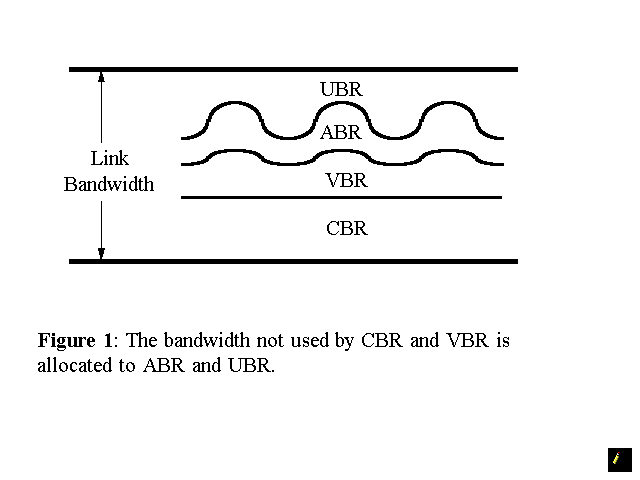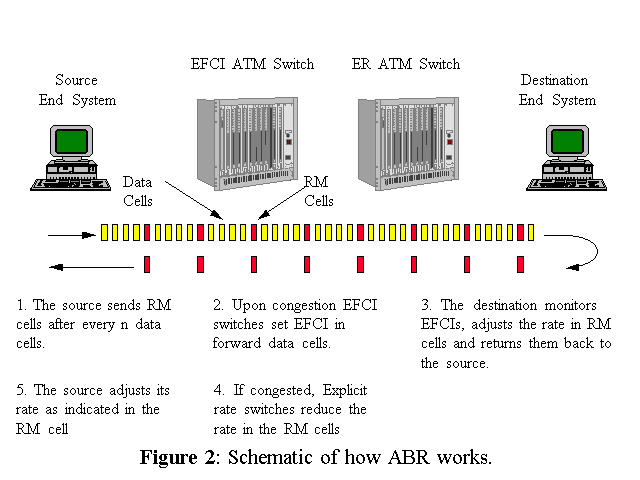
[Text and figures as sent to Network World. The final edited article appeared on June 24th issue of Network World.]
Today when you use Internet for communication, you share the bandwidth with hundreds of other users on each link on the path. The bandwidth of each link is dynamically divided among all contending users. As new users join, or old users leave the network, the share of total bit rate available to you may decrease or increase. This is the concept of "Available bit rate (ABR)".
Most Internet users do not make any prior reservation of bandwidth and are happy to share whatever is available. Telecommunications networks on the other hand traditionally want users to declare their bandwidth requirements, for example, 64 kbps, 1.5 Mbps (T1), or 45 Mbps (T3). This helps them manage resources and make quality of service (QoS) guarantees.
ATM networks, which are being designed jointly by the telecommunication and computer industry, provides the best of both worlds -- QoS guarantees and bandwidth sharing. They are being designed to support ABR service along with the traditional "constant bit rate (CBR)" and "variable bit rate (VBR)" services. CBR users declare their bandwidth requirement (rate) at the time of connection setup. The network reserves that much bandwidth for them and guarantees their quality of service in terms of cell loss rate, transit delay, and delay variation. Uncompressed or compressed video are examples of applications that may use CBR. The variable bit rate users declare their peak rate and a sustained (average) rate. As long as they keep their load within the declared parameters, they are also guaranteed requested QoS parameters. Some VBR services are not delay sensitive while others are. ATM networks, therefore, offer two types of VBR services: real-time VBR (VBR-RT) and nonreal-time VBR (VBR-NRT). Teleconferencing is an example of VBR-RT while multimedia email is an example of VBR-NRT.
The bandwidth that is not used by CBR and VBR services is "available" for distribution among users that are not delay sensitive (See Figure 1).

Of these users, some are willing to control their load dynamically as demanded by the network. These users may want the network to guarantee cell loss rate but do not care if they have to wait a little while to get to their destinations. The ABR service is designed for such users. File transfers and email are examples of applications of the ABR service. Finally, there are users who cannot control their traffic but want to use the network if bandwidth is available. They use the "unspecified bit rate (UBR)" service. For such users, the network makes no promises whatsoever. In particular, if network gets congested, UBR cells may be dropped. However, network service providers may use sophisticaed techniques to keep the cell discard rate low. Network monitoring traffic and news are examples of the UBR applications.
In some sense, ATM services are like those offered by airlines. CBR is confirmed reservations with no recourse if you do not show up. VBR is like confirmed reservation but you do not pay if you do not show up. ABR is standby. You get to go if seats are available. Having standby service is good for the airline. They can fill their seats that would otherwise would have gone empty. The service is also good for passengers. They can travel cheaply particularly if they don't have to be at their destinations at a certain time. UBR service is not currently offered by the airlines. Passengers travelling on UBR class may be allowed to board a plane but may be asked to leave at connecting airports if seats are not available. ABR users would generally be asked to stay home as much as possible if their routes are congested. In addition, the standby users may purchase certain number of confirmed seats. This combination of confirmed and standy seats is what is reflected in the minimum cell rate of ABR services. [You can draw a cartoon here of standby passengers at the airport]
The ABR service was added by the ATM forum traffic management group in its November 1993 meeting. Since then the group has been working on specifying the mechanisms to support this service. The specification has been designed to allow considerable flexibility to both switch and network interface card (NIC) vendors. Only those rules that are required to ensure interoperability and proper operation have been specified.
At the time of virtual circuit (VC) setup, the sources negotiate a peak cell rate (PCR), minimum cell rate (MCR), and a few other parameters. The connection is allowed only if all the switches on the path can support MCR. Most connections are expected to ask for an MCR of zero. The PCR is typically set by the switches to the bandwidth of the bottleneck link on the VC's path. During data transmission phase, the sources are required to periodically (after every n, say 32, data cells) send a "resource management (RM)" cell that indicates their current cell rate and other parameters. The RM cells are returned back to the source by the destination. These backward RM cells provide the primary means for the switches to indicate new rate for each VC. The RM cells contain an "explicit rate (ER)" field, which starts out at PCR but can be reduced by any switch on the path. When the RM cell returns to the source, it adjusts its rate to the new ER value specified in the RM cell. (See Figure 2).

Some of the existing switches, particularly those designed for UNI 3.0 specification, may not handle the RM cells. Instead, they set a bit in headers of all data cells passing through them whenever they are congested. This bit is called "Explicit Forward Congestion Indication (EFCI)." The destination keeps track of these bits and reduces the rate in subsequent RM cells that it returns to the sources. Thus, when the new traffic management document is published, existing EFCI switches will not have to be replaced. They will continue to interoperate with newer ER switches.
ABR is expected to be the most popular service on ATM networks. In particular, the LAN emulation will use ABR services. As ATM networks become part of the Internet, most of the present data applications will also use ABR services.
The traffic management document is being finalized by the ATM Forum. It is scheduled to be sent out for ballot in August 1995. Products implementing the new specifications should appear soon after.
About the author:
----------------
Dr. Raj Jain is the author of FDDI Handbook and is the inventor of several congestion control mechanisms including those used in DECnet, OSI, Frame Relay, and ATM networks. Currently he is a professor of Computer and Information Science at the Ohio State University and is an active member of the ATM Traffic Management Group. See world-wide web page
http://www.cse.wustl.edu/~jain/for his publications including a detailed survey paper on ATM congestion control.